|
TWIN CITIES MUSIC
PUBLICATIONS
Here is a list of some of the local rock 'n' roll magazines and books of
the 1960s and '70s. If you know of others or have additions, corrections,
or photos, please contact me!
 Beat
Magazine: John Pratt: "I do remember Beat Magazine, which was a
national publication that was sold through various top-40 stations around the
country, with editions tailored to each station's markets. Here, it was KDWB
Beat. KRLA had the Los Angeles edition of Beat;
[at right is] a cover photo of an October 1967 edition of KRLA Beat."
The address given is Beat Publications, 9125 Sunset Blvd., Los Angeles. Beat
Magazine: John Pratt: "I do remember Beat Magazine, which was a
national publication that was sold through various top-40 stations around the
country, with editions tailored to each station's markets. Here, it was KDWB
Beat. KRLA had the Los Angeles edition of Beat;
[at right is] a cover photo of an October 1967 edition of KRLA Beat."
The address given is Beat Publications, 9125 Sunset Blvd., Los Angeles.
We have copies of four issues of KDWB Beat. Each has a "local"
page centered on the station. The local page from the August 26, 1967
issue ("Special Hippie History Issue") featured pictures of Twin Cities music
industry folk (Tac Hammer, Ira Heilicher, Charlee Brown) with the Jefferson Airplane, the Electric Prunes, and the Shadows
of Night during an outing on Lake Minnetonka. (See detailed in chronology
above.) The issue also reported on the Monkees concert in NYC, where the
opening acts were Lynn Randell and Jimi Hendrix. Micky did his best James
Brown imitation.
The local page from October 21, 1967 reports KDWB's Earl L.
Trout III being "jailed" in a charity stunt. It shows him broadcasting live from
the corner of 7th and Hennepin, and Minneapolis police "arresting" him and
taking him to jail until enough money was raised for the Leukemia Foundation to
"bail" him out. (See details in 1967 above.)
The January 27, 1968 issue featured a silly "history" of KDWB going back to the
cave men. It also supported a High School Christmas concert series
involving 13 schools from the metro area (including St. Louis Park).
And the February 24, 1968 issue featured KDWB DJ
Earl L. Trout III's national-but-futile letter-writing campaign to bring the
Beatles back to the U.S.
City Pages: Music and
Entertainment, plus news and Features for People Living
in the City. Continuation of Sweet Potato
Magazine. First issue was December 3, 1981.
If you want to know what went on musically in the Twin
Cities, City Pages is where to find it.
Connie's Insider - See
Insider
Flip Side: An Illustrated History
of Southern Minnesota Rock & Roll Music from 1955-1970;
Jim Oldsberg, 1997.
Thee Apostles/Stormy Monday; Little Caesar & The
Conspirators; The Chances R; The Continental Co-ets; The
D.C. Drifters; The Defiants; The Depressions; The Emperors;
The Epicurians/Highway; The Exotics/19th
Amendment;; The Ferraris; The Furys; The Gestures/Madhatters;
Mike Glieden & the Rhythm Kings; Steve Carl
& the Jags; The Korners of Time; Kreed; Leaves of Grass; The
Messengers; The Mods; The Mustangs; The Night
Crawlers; The Nite-Sounds; The Notorious Noblemen; The
Pagans; The Pilgrims; Prince & the Paupers; The Radiants; The Rhythm Rockers; The Rogues; The Secrets; The
Shades; The Shags; The Silver Shadows; The
Sensational Sleepers; Steve Ellis & the Starfires; The
Stingrays; TBI; Us; Vultures; Wire
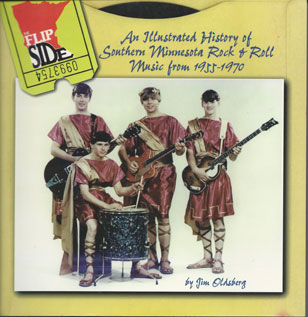
Hair was an underground paper published in
1968-69. Issue 2's cover featured a naked girl with a
breast in her cereal bowl with the caption "Some mornings
nothing goes right!" Publishers and contributors
included Evan and Sally Stark, Jack Cann, Steve Kimmel, and
Gus and Marsha Slelzer. Much of the content was on
local housing news, including reports on the condition of
housing, particularly on Nicollet Island. One issue
had a long article on "Yellow Submarine" but I couldn't make
out whether they liked it or not. In April 1969 there
were very big ads for Labor Temple shows.
Hundred Flowers
was published from April 17, 1970 to April 4, 1972. The name came from a
quote from Chinese Communist Party Chairman Mao Zedong during a period in 1956
where the Chinese people were encouraged to share their opinions of the
regime: "The policy of letting a hundred flowers bloom and a hundred
schools of thought contend is designed to promote the flourishing of the arts
and the progress of science." The course was soon reversed and may have
been a trick to flush out dissidents.
Offices of the magazine were first
located in the Eastside Citizens' Community Center at 100 University Ave., but
they reported that they were kicked out. By 1971 they were located at
"Liberty House," 529 Cedar Ave. So., operated by Minneapolis activist Marv Davidov. It was primarily a political
underground newspaper, publishing communiques from Bernardine Dohrn of the
Weather Underground. But it had some music reviews and ads in it as well.
In its January 1, 1971, issue it reported a rash of thefts of local
instruments. It also complained that the Depot had withdrawn its free
tickets to the paper's staff because of critical reviews of its concerts.
They responded by calling the Depot a "smoky, smelly, overcrowded plastic
environment to hear often outrageously loud performances.. pathetic
efforts at pleasure." It also reported on an experiment where pregnant
women took LSD. They reported no birth defects, but all the babies turned
out to be girls. The sample size was... 10.
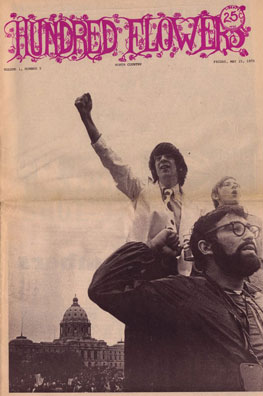
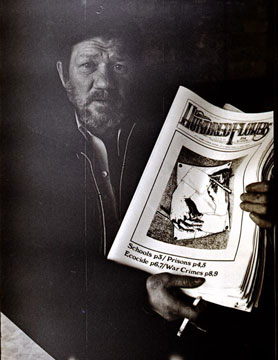
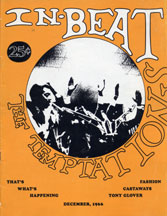 In-Beat Magazine ("That's What's Happening"):
This magazine was published monthly by Steven Kaplan out of his living room.
Kaplan sold subscriptions at the Teen Age Fair at the State Fair [presumably
August 66] for $2 - each subscriber got a free 45 rpm record, so the
subscriptions were essentially free. In-Beat paid Twin City a Go Go
(see below) $1500 not to compete. The first issue came out in September 1966. In-Beat Magazine ("That's What's Happening"):
This magazine was published monthly by Steven Kaplan out of his living room.
Kaplan sold subscriptions at the Teen Age Fair at the State Fair [presumably
August 66] for $2 - each subscriber got a free 45 rpm record, so the
subscriptions were essentially free. In-Beat paid Twin City a Go Go
(see below) $1500 not to compete. The first issue came out in September 1966.
Kaplan remembers: "we were out only a few issues when we got some good
national ads: Sprite automobiles and Clairol products among them. A coup for a
small magazine.
"Also, a few months after we were out, the publisher of Where magazine
called and wanted to meet. By this time our magazine was hot: I went from being
a nerd to being hip in two issues (and back to being a nerd again after we
stopped publishing). But we were hot and this publisher wanted us to associate
our name with his, so he offered us an office — for free — and, this was
the clincher, free meals every day at Luigi’s
restaurant, which at that time was on the main floor of the
Lumber Exchange, where Where was located (on the 12th
floor). We took the office and were able to move out of my
apartment. It was a big office and we always kept the doors
closed because it reeked of marijuana fumes.
"One of our biggest coups came early in the season. Big
names Chad & Jeremy (though, of course, no one today has any
idea of who they were) were booked for the fair, but never
showed up. It was an outrage and everyone — particularly the
mainstream media — was trying to find out what happened.
Chad & Jeremy called us, however, and sat down for an
explanatory interview with us, the only interview they gave
(and, perhaps, the last one anyone ever really cared about).
[See 1966 above.]
"Our best time was with James Brown. He had come (maybe to
the Flame Ballroom) and we made arrangements to photograph &
interview him. Brown was my personal idol and I couldn’t
wait to see him perform. We went to the concert and though
it was sold out, there was hardly a white guy there: maybe 3
or 4 in the whole place (Danny & I were half of that). When
the show was over we went back stage where Brown, who was
indeed the hardest working guy in show business, was sitting
at a chair with an attendant at both legs, each unlacing his
high-laced boots. I started asking him my brilliant
questions when he stopped me. “This is no place to do an
interview,” he said, and, of course, he was right. “Why
don’t you guys fly back with me to Cincinnati. That way we
can do the interview on the plane, and it will be quiet and
we won’t be rushed. After I’ll put you guys up in a hotel
and in the morning we’ll tour King Records.” And that’s
exactly what we did. We flew back in his Lear Jet, he, James
Foxx, Danny & I. The plane’s interior was about as big as a
restaurant booth, and the loudspeakers played Vivaldi."
The (final?) issue of In-Beat came out in August
1967. Kaplan and friends went to San Francisco for the
Monterey Pop concert in 1967, where hippies were in and
teenage fanzines were out, and that was the end of
In-Beat. Kaplan now edits the magazine Minnesota Law
and Politics.
Insider: The Insider began in about April 1966 as
the T.M.C. Insider, a mimeographed newsletter put out by Trestman Music Center
and edited by Timothy D. Kehr.
It was
strictly a trade sheet for the burgeoning teenage musicians
in the Twin Cities (one estimate was that there were 4,000 of them).
"The Blue Musical Voice of the Midwest." It had news about the groups, ads for TMC and band
instruments, and featured an instructional column called
"Drummers' Beat." Colman “Connie” Hechter, a
musician and former publicist for Mercury Records was the
publisher, editor, and reporter, with Trestman acting as
sponsor. In 1967 Hechter began to publish the magazine independently as Connie's
Insider, with music industry trade news, and music,
arts and lifestyle features for and about the people of
Minnesota, Iowa, Nebraska, Wisconsin and the Dakotas. Looking on-line at the
holdings of the Minnesota Historical Society and the
Hennepin County Library (downtown-Special Collections), it
would appear that the last Connie's Insider was the
July/August 1971 issue, and then it was just the Insider
from September 1971 to May/June 1978. Hechter passed
away in 1978 and the publication became the Musician's
Insider until it ended in 1980. See the story in
Twin Cities Funk & Soul, page 28.
Johnny Green and the Greenmen by Mark Starks,
2010. Available at
Lulu
Little Sandy Review, edited by Paul
Nelson and Jon Pankake, 1960-1968
This was a little paperback-sized magazine that contained
mostly reviews of folk recordings. Although the issues
are not dated, it is estimated that the first issue came out
in March 1960. Initial cost was 30 cents, and the
office was listed as 3220 Park Ave. So. in Minneapolis.
The name was a poke at the "Little Sandys" (girls who wanted
to be Sandra Dee) on campus. There was not much local content. The editors were
folk and blues purists, and launched often hilarious blasts
at "all phonies who water, dilute, and pervert" folk music.
It was very clear who they liked and who they thought were
purveyors of "folkum."
Likes:
- Woody Guthrie
- Pete Seeger
- New Lost City Ramblers
- Dylan's first album
- Peggy Seeger
- Joan Baez (off and on)
- Ramblin' Jack Elliott
- Jean Ritchie
- Leadbelly
- Carter Family
- Cisco Houston
- Koerner, Ray, and Glover
- Stringbean ("important, gifted, and versatile
country musician")
Hates:
- Harry "Belaphoney"
- Kingston Trio
- Limelighters
- Coachmen
- Bud and Travis
- Josh White ("basks in moneyed glow of the expense
account set")
- Glenn Yarborough ("sounds like a male Judy Garland")
- Odetta ("a poor musician")
- The Weavers ("not much more 'folk' than Jo Stafford
- just know how to play-act better")
- Burl Ives ("darling of suburban matrons")
- Jimmie Rodgers (mad because he claimed he wrote
traditional songs)
- Smothers Brothers ("not folk and not funny")
- Peter, Paul, and Mary ("atrocious artificially
canned, commercial enthusiasm")
Barry Hanson was the main blues reviewer - he went on to
become Dr. Demento. He moved west but continued to
contribute. In January 1964 the magazine graduated to
professional printing and slick paper and the price went up
to 85 cents. The next issue came out in March and was
$1. Then there was a gap until 1965. After that
started Volume 2 in July 1966, and the magazine had moved to
California, edited solely by Hanson, although Nelson (who
had moved to New York to work at Sing Out!) and
Pankake had offered to contribute. Another
three issues came out but the last was in about February
1968. Bound copies are available to read at the
downtown Minneapolis library.
Lost and Found: a '50s/'60s Rock & Roll 'Zine; Jim
Oldsberg
Volume 1: Minnesota/Iowa. Out of print
Volume 2: Minnesota/Wisconsin, 1993. May be
some copies at Half Price Books in Apple Valley
Jades, Benders, Velquins, DelRicos, Flames, Faros, Memories,
Private Property of Digil, Lord Verley
Moss &
The Moss Men, Denny Noie/In Crowd/4th of Never, Journeymen,
Target/Tee Pee Records,
Yetti-Men, Calico
Wall, Crucible, Galaxies, Spacement, Aldon & the E.C.s/Thundermen,
Ray Peters
Volume 3: Illinois/Minnesota. Out of Print.
Volume 4: North and South Dakota, 1997. Out
of Print.
Terry Lee & the Poorboys, Davey Bee & the Sonics, Ronnie Ray
& the Playboys, Dale Gregory & the
Shouters, Bobby Vee & the Shadows, Boss Tweads, Treasures,
Myron Lee & the Caddies, Pawnbrokers,
Steve Rowe & the Furies, Fragile Zookeeper, Escorts Four,
Jay Bee & the Kats, Richie Wynn & the
Tornadoes, Bleach Boys, Shattoes/Chateaux, Ken Mills, Sir
Laurence & the Crescents
Volume 5: Northern Minnesota. Back in
Print! See
Amazon.com
Rockets, Little John & the Sherwood Men, Reveliers, Renowns,
Tommy Lee & the Orbits, Jeujene & the
Jaybops, Canoise, Avengers, Pretenders, Chet Orr & the
Rumbles, Howie Butler & the Reflections,
Outcasts,
Titans, Sounds Like Us, Devilles, Vaqueros, Unbelievable
Uglies, Novas
Metanoia was a local arts magazine from the late '60s. In 1968 it was
described as an Underground magazine with a circulation of 5,000, mostly college
students and instructors.
The Midwest 60s Rock Art Collection by Tom W. Tourville, 1996.
Features the Legendary Danceland Collection. Out of Print.
The Minneapolis Flag was a do-it-yourself
newsletter than was political and musical, with some concert
reviews in the April 10, 1970, issue. Classifieds were placed
mostly by musicians and by photographers looking for "nice
looking liberated chicks" to do nude modeling.
Minnesota Music Directory was first
published in March 1981 by Sweet Potato Magazine, and then
each February from 1982 to 1987 by the City Pages.
(Perhaps more but these are what the Minnesota Historical
Society Library has in hard copy.)
Minnesota Rocked! The 1960s; Tom W. Tourville,
1966 (the fourth edition was the last that I know of). This is an amazing
list of Minnesota bands and their recordings. Out of Print.
Music Legends: a Rewind on the Minnesota Music Scene;
Martin Keller, D Media, Inc., 2007. See
Amazon.
In 1967 B Sharp Music published Music Scene, a
competitor to the Insider. It had a wider audience
than the first issues of the Insider, with bios of
local and national musicians. The newsletter was written by Timothy D. Kehr.
New Twin Citian: See Select
On the Rocks came way after my 1974 cutoff, but since Jeff
Kleinbaum found this, why not? This issue, Volume 2, Number 1, is from
July 1989.
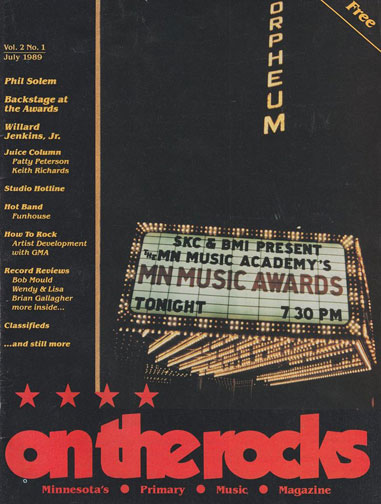
Select was not a music publication per se, but it did have a lot
of great ads for night clubs for the sophisticated members of Twin Cities
society. It also published a great directory of restaurants and night
clubs each year. Copies are available at the Minnesota Historical Society. The progression of the magazine was:
- Select... The Magazine of Quality for
Discriminating Minneapolis (September 1958 - February
1959)
- Select Minneapolis (March to April 1959)
- Select St. Paul (July 1959 to July 1960).
Heavy on Hi-Fi ads.
- Select: Twin Cities Review of Fashion,
Travel, Arts and Society (May 1959 to March 1962)
- Select Twin Citian: Minneapolis/St.
Paul Review of Fashion, Travel, Arts and Society (April/May1962 -
July 1963. Incorporated FM radio program listings
in July 1962.
- Twin Citian: Minneapolis/St. Paul
Review of Fashion, Travel, Arts and Society (August 1963 -
June 1964)
- New Twin Citian (January to December, 1970).
Included program listings for WLOL radio; no pop music
listings
A Simple Twist of Fate: Bob Dylan and the Making of
Blood on the Tracks; Andy Gill and Kevin Odegard;
Da Capo Press, 2004. See 1974 above.
Sweet Potato: This precursor to the City Pages
started as a monthly in August 1979. The publisher was Tom Bartel and
Martin Keller was the Editor (then the Music Editor). Sweet Potato
sponsored the first Minnesota Music Awards (nicknamed the Yammies) in 1981.
The last edition of the magazine was November 25, 1981, where it announced that
the name was being changed to City Pages.
TMC Insider - See Insider
Twin Citian: See Select
 Twin
City a-GoGo ("The magazine for Twin City Young Adults on the Go"): Editors were David Jass (vice-president of Young
Adult Productions and son of Twin Cities television personality Mel Jass) and Bruce
Goldstein (associated with Century Camera). This was a
jam-packed publication. The first issue in May 1965 featured the
Chancellors on the cover (see right). Free subscriptions were
available until October 1, 1965. It grew to be a very popular publication:
In 1965 there were 3 staff members, and by January 1966 there were 30. Twin
City a-GoGo ("The magazine for Twin City Young Adults on the Go"): Editors were David Jass (vice-president of Young
Adult Productions and son of Twin Cities television personality Mel Jass) and Bruce
Goldstein (associated with Century Camera). This was a
jam-packed publication. The first issue in May 1965 featured the
Chancellors on the cover (see right). Free subscriptions were
available until October 1, 1965. It grew to be a very popular publication:
In 1965 there were 3 staff members, and by January 1966 there were 30.
David Jass remembers:
"We started all of this at the Teen Fair at the Minnesota State Fair [1965]. I think
the teen fair only lasted that one
time. We had a life-size display of the Beatles. Get your picture taken with the
Beatles was a hit. It cost $.75. We also sold what we called go go hammers. The
idea was to hit members of the opposite sex with them. It was a plastic hammer
deal with accordion yellow ends that make a loud "pop" sound. We hired young
ladies in swimming suits and tennis shoes to sell them. What a hit. By the 4th
day of the Teen Fair we chartered an airplane to fly in more hammers. The last
day of the fair I was in a cab going home. I had only one hammer left. Broken.
The cab driver said his son had to have one. He paid me $1.75 for it. We also
had kids sign up with name, phone, and address if they would be interested in a
magazine for teens in Minnesota. Thus the list of finally 10,000 names.
"I have the original copy of a' GoGo . It is a small digest size mag of
around 10 pages. Bruce and I wrote all the articles using pseudonyms. My fashion
column "fling into spring" was my most memorable. We sold advertising to local
businesses. Enough money was made to pay the rent for our office (above the
Cascade 9 Bar and Grill in Mpls) and other expenses. Nancy Nelson was our
secretary. We hired kids to call the rock n roll radio stations to plug our
magazine. The radio stations started getting suspicious and stopped taking these
calls. Kids would then call pretending some other "teen" topic and then slip in
how much they loved Twin City A Go Go.
 "When the Beatles came to the Twin Cities, I had a room one floor below them at
some motel in Mpls. I met them, not much talking, but a thrill for me. I was 21
at the time. During their press conference one of our guys (Karnstedt) tossed
some issues of our magazine (#2) at the interview table. The boys picked them up
and started clowning around with them. Our 3rd issue shows them with our
magazine. Kind of cool. "When the Beatles came to the Twin Cities, I had a room one floor below them at
some motel in Mpls. I met them, not much talking, but a thrill for me. I was 21
at the time. During their press conference one of our guys (Karnstedt) tossed
some issues of our magazine (#2) at the interview table. The boys picked them up
and started clowning around with them. Our 3rd issue shows them with our
magazine. Kind of cool.
"I left the corporation shortly after this escapade. My partner Bruce Goldstein
continued for maybe one more issue. He began selling our list of 10,000
subscribers. I think that he sold the magazine, which was to become InBeat.
"Well, lots of memories here. I' m now 64 years old. Have spent my working
life as a teacher, social worker, and contractor. Have now lived in San Diego
California for the last 30 years."
Thanks, David, for your memories!
Twin City Where was a nationally franchised magazine that published here
in about 1966. Howard Goldenberg was the editor.
Marcia from Marcia and the Lynchmen reports that they were one of the teen bands
highlighted in the St. Paul Pioneer Press Pictorial Magazine, June 5,
1966, “Those Teen Bands.” The article was entitled “Behind the Twang of the
Guitar” and the text was by Bill Diehl. Maddie
Shay scanned her copy
for us!
Return to Twin Cities Music Highlights
|

 Beat
Magazine: John Pratt: "I do remember Beat Magazine, which was a
national publication that was sold through various top-40 stations around the
country, with editions tailored to each station's markets. Here, it was KDWB
Beat. KRLA had the Los Angeles edition of Beat;
[at right is] a cover photo of an October 1967 edition of KRLA Beat."
The address given is Beat Publications, 9125 Sunset Blvd., Los Angeles.
Beat
Magazine: John Pratt: "I do remember Beat Magazine, which was a
national publication that was sold through various top-40 stations around the
country, with editions tailored to each station's markets. Here, it was KDWB
Beat. KRLA had the Los Angeles edition of Beat;
[at right is] a cover photo of an October 1967 edition of KRLA Beat."
The address given is Beat Publications, 9125 Sunset Blvd., Los Angeles. 


 In-Beat Magazine ("That's What's Happening"):
This magazine was published monthly by Steven Kaplan out of his living room.
Kaplan sold subscriptions at the Teen Age Fair at the State Fair [presumably
August 66] for $2 - each subscriber got a free 45 rpm record, so the
subscriptions were essentially free. In-Beat paid Twin City a Go Go
(see below) $1500 not to compete. The first issue came out in September 1966.
In-Beat Magazine ("That's What's Happening"):
This magazine was published monthly by Steven Kaplan out of his living room.
Kaplan sold subscriptions at the Teen Age Fair at the State Fair [presumably
August 66] for $2 - each subscriber got a free 45 rpm record, so the
subscriptions were essentially free. In-Beat paid Twin City a Go Go
(see below) $1500 not to compete. The first issue came out in September 1966.

 Twin
City a-GoGo ("The magazine for Twin City Young Adults on the Go"): Editors were David Jass (vice-president of Young
Adult Productions and son of Twin Cities television personality Mel Jass) and Bruce
Goldstein (associated with Century Camera). This was a
jam-packed publication. The first issue in May 1965 featured the
Twin
City a-GoGo ("The magazine for Twin City Young Adults on the Go"): Editors were David Jass (vice-president of Young
Adult Productions and son of Twin Cities television personality Mel Jass) and Bruce
Goldstein (associated with Century Camera). This was a
jam-packed publication. The first issue in May 1965 featured the
 "When the Beatles came to the Twin Cities, I had a room one floor below them at
some motel in Mpls. I met them, not much talking, but a thrill for me. I was 21
at the time. During their press conference one of our guys (Karnstedt) tossed
some issues of our magazine (#2) at the interview table. The boys picked them up
and started clowning around with them. Our 3rd issue shows them with our
magazine. Kind of cool.
"When the Beatles came to the Twin Cities, I had a room one floor below them at
some motel in Mpls. I met them, not much talking, but a thrill for me. I was 21
at the time. During their press conference one of our guys (Karnstedt) tossed
some issues of our magazine (#2) at the interview table. The boys picked them up
and started clowning around with them. Our 3rd issue shows them with our
magazine. Kind of cool.